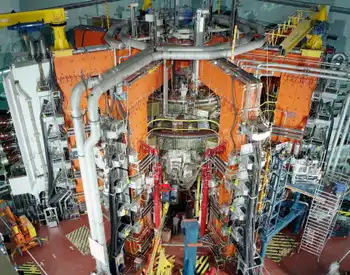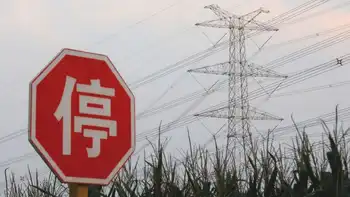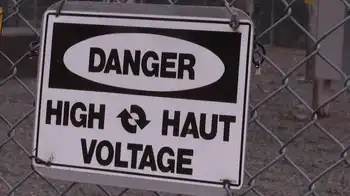Utility may face scrutiny over response to outages
By Associated Press
Arc Flash Training - CSA Z462 Electrical Safety
Our customized live online or in‑person group training can be delivered to your staff at your location.

- Live Online
- 6 hours Instructor-led
- Group Training Available
Even during intense thunderstorms like those that hit the state recently, utilities are required under state rules to bring back electricity within 2 1/2 days to 90 percent of customers without power.
About 360,000 of Detroit Edison's customers lost power over a five-day span, most on June 8. But tens of thousands still had no electricity as of June 13, qualifying them for a $25 credit - though the utility likely will ask for a waiver from the Michigan Public Service Commission, citing an event caused by "an act of God."
Regulations reviewed by The Associated Press also say it is unacceptable if more than 5 percent of phone calls to a utility are blocked or it takes on average more than 90 seconds to answer customer calls. Yet Detroit Edison's phone system struggled, at one point handling just one-fourth of the 40,000 calls it should have been able to process in an hour.
When asked about a possible PSC review, Detroit Edison President Bob Buckler said: "I believe the work we have done here will stand in very good stead."
It took 3 1/2 days to get power back to 90 percent of those without power, Buckler said.
"We got very close, and I think that's as good as any utility in the country could do under those kind of circumstances."
Buckler said the utility is committed to making repairs "faster and faster" and that he is "tremendously proud" of his employees.
The utility has fixed the phone problem, though it does not know its root cause.
"It made things more challenging because we discovered later in the day that outages were more extensive than we originally thought," spokeswoman Eileen Dixon said.
Dixon said blocked calls did not affect the utility's response because the phone system is not the only way it finds out about outages. Detroit Edison could not get worker reinforcements from out-of-state utilities as quickly as normal because those companies were dealing with downed power lines throughout the Midwest, she said.
"The biggest obstacle was there was one storm after another," Dixon said, calling the storms the fifth-worst in the company's 105-year history. "It's two steps forward, one step back. It's really been quite a challenge."
More storms knocked out power to other homes and slowed crews working to restore outages caused by earlier storms.
A frustrated Bill Charlton, a 52-year-old IT consultant from Oakland County's Commerce Township, said his house lost power at 6:15 a.m. on June 10 in a neighborhood where no storms had struck. It came back on at noon June 13.
"The rumors are they had to shut down our grid to work on another one," Charlton said. "If they're going to shut down a perfectly nice neighborhood, you would have thought they would have given us some notice. We were never given steps to protect our perishables. There didn't seem to be a reason, no communication from (Edison). We could not get through, they said to check the Web site. But we had no power, so our computer was not working."
DTE Energy Co.'s Detroit Edison unit has 2.3 million electric customers, mostly in southeast Michigan. The state's second-biggest utility, Consumers Energy, has 1.8 million customers in 60 counties in the Lower Peninsula.
About 358,000 customers of CMS Energy Corp.'s Consumers Energy unit lost power last weekend. All but 1,900 had it back by Wednesday night - before the new storms hit - while thousands of Detroit Edison customers who lost power earlier in the week were still waiting.
The Public Service Commission, which sets rates and rules for utilities, said the vast majority of hundreds of electric complaints it got this week came from the metro Detroit area.
Regulators are no strangers to reviewing how utilities respond to bad weather.
The PSC investigated after three large storms in the 1990s and again after a 2003 blackout left 50 million people in southern Ontario and the United States, including Michigan, without power.
PSC staff in 1999 recommended working with Detroit Edison to improve how it responds to complaints and the responsiveness of its toll-free number. Customers had complained about long waiting times before Detroit Edison added more customer service representatives.
Regulators routinely meet informally with utility officials after storms to discuss outages and other issues. It is too early to know if the commission will order a formal review of the latest events but it is "certainly possible," PSC spokeswoman Judy Palnau said.
One issue is tree trimming, which is designed to keep people safe and the power on during storms. The 2003 blackout began when tree limbs touched a power line in Ohio.
After investigating in 2004, Michigan regulators were satisfied that all state power companies had established routine trimming practices. But in 2005 they decided to track Consumers Energy's tree-trimming spending during a rate case and earlier this week rejected the utility's request to stop, saying Consumers' past failure to spend enough "has compromised service reliability, quality and safety."
Detroit Edison's tree trimming has not had to undergo similar oversight, and the PSC is satisfied with the utility's spending, Palnau said.
In the utility's defense, the storms that followed the initial storms appear to have damaged the Detroit area more than other areas. The damage was so severe that up to 40 workers had to be on site to restore power to a neighborhood, Dixon said.
Detroit Edison's customers also are concentrated in a metropolitan area - Oakland County is particularly "tree-intensive," according to the PSC - while Consumers Energy probably benefits from having customers spread across the state.
White Lake Township Supervisor Mike Kowall, who still had no power June 13, described the damage to his Oakland County community as looking "like a giant weed wacker went through." He said he would not blame Detroit Edison for long outages.
"It was a big storm. They have aboveground power lines. Therein lies the problem," Kowall said.
Others remained frustrated, though.
State Rep. David Law, R-Commerce Township, wants an independent review conducted in the wake of the outages.
"The frustrating part for me as a lawmaker is when calls aren't returned or when promises are made on when the power will be back and it's not back," Law said. "That's tough for residents and myself to understand."











